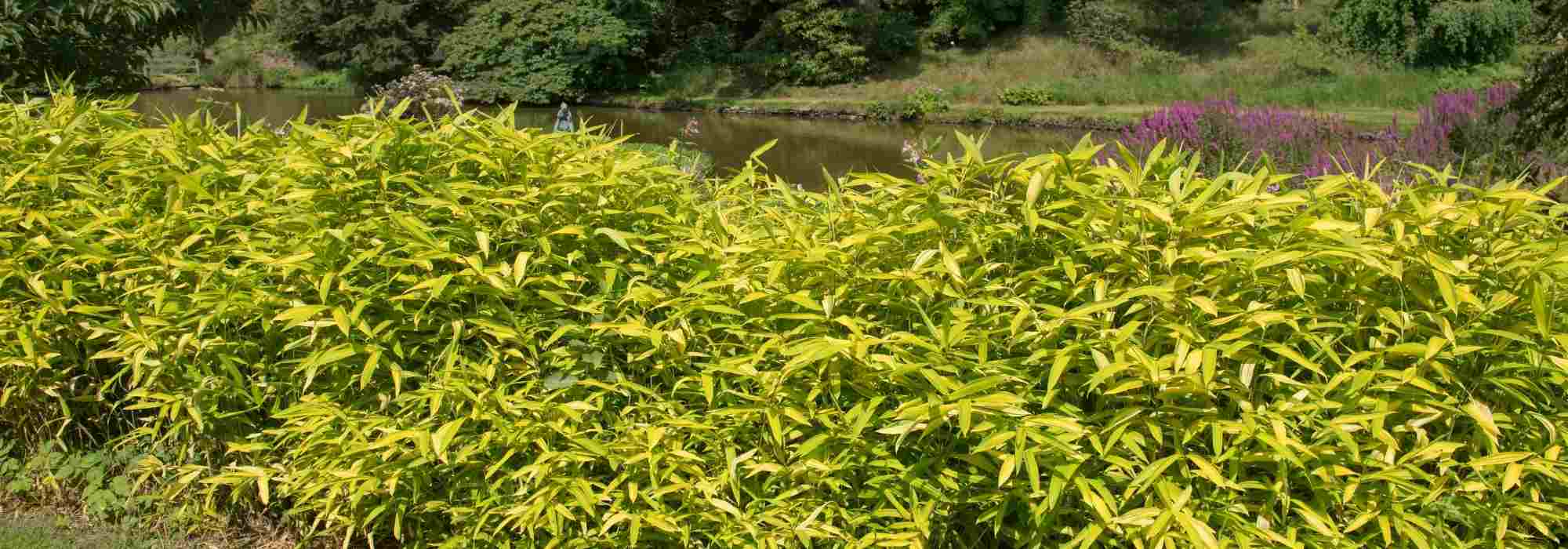
Pleioblastus, dwarf bamboo: planting, growing
Contents
Pleioblastus in a nutshell
- It is a dwarf or medium-sized bamboo that is very bushy
- Quite running, it makes an excellent evergreen groundcover that is decorative and bright
- It generally does not exceed 1 m in height
- Perfectly hardy and vigorous, this bamboo thrives everywhere
- It is particularly well-suited for pot cultivation, as a border, or in a small hedge
A word from our expert
Pleioblastus is a dwarf or medium running bamboo that is perfectly evergreen and well-branched. Some varieties are infinitely graceful with their very bright foliage: Pleioblastus auricomus is dressed in golden-green foliage, while Pleioblastus fortunei ‘Variegatus’ is variegated. Depending on the species, it forms a superb carpet, even being capable of replacing lawn in non-trodden areas of the garden or creating elegant small clumps. It is ideal for decorating small gardens and for container growing.
The smallest varieties (Pleioblastus pygmaeus ‘Distichus’, Pleioblastus pumilus, ‘Vagans‘) reaching only 30 to 70 cm in height, make excellent groundcover in borders or under trees. They provide a graphic and structural presence in the garden even in winter.
Offering good hardiness, down to -25 °C, this bamboo is well-suited to harsh climates and difficult situations. It also tolerates occasional drought and thrives in sun or shade in warm climates, in any cool but well-drained soil.
One of the easiest to grow, it establishes itself easily and almost anywhere, to the point of becoming invasive. Simply install a rhizome barrier at planting to contain its enthusiasm.
Discover our collection of dwarf bamboos perfectly suited for zen, wild, exotic, or contemporary gardens!
Description and botany
Botanical data
- Latin name Pleioblastus
- Family Poaceae
- Common name Pleioblastus, dwarf bamboo
- Height 0.30 to 4.5 m
- Exposure Sun, partial shade
- Soil type light, well-drained
- Hardiness below -15°C
Pleioblastus is a dwarf or medium-sized bamboo, belonging to the Poaceae family, which includes all other bamboos. The genus Pleioblastus comprises around 70 low-growing bamboo species, including Pleioblastus pumilus, Pleioblastus viridistriatus ‘Auricoma’ or ‘Vagans‘, and Pleioblastus fortunei ‘Variegatus’, originating from Japan and China. These bamboos are predominantly very running, meaning they spread quickly through their rhizomes. This invasive nature should be tempered by installing a rhizome barrier to contain their vigorous growth.
It develops somewhat like Fargesia, starting from a compact but suckering stump. Pleioblastus bamboos are highly variable depending on the species. They form a clump with an upright habit or particularly low growth. Some reach heights of 5 m, such as the bamboo Pleioblastus linearis, while others, like Pleioblastus pygmaeus, do not exceed 1 m, and even less than 50 cm in height for the Pleioblastus pygmaeus ‘Distichu’, which is a groundcover variety. This is why they are commonly referred to as “dwarf bamboos,” due to their generally more moderate growth compared to other bamboo species. In contrast, giant bamboos like Phyllostachys rarely exceed 5 m in height. It compensates for its small size with strong horizontal growth, spreading over large areas, making it an excellent groundcover.
It is characterised by fine, closely packed canes, pale green in colour, sometimes brown-green, with a diameter of 1 to 2 mm. The culms branch into fine stems, bearing leaves.
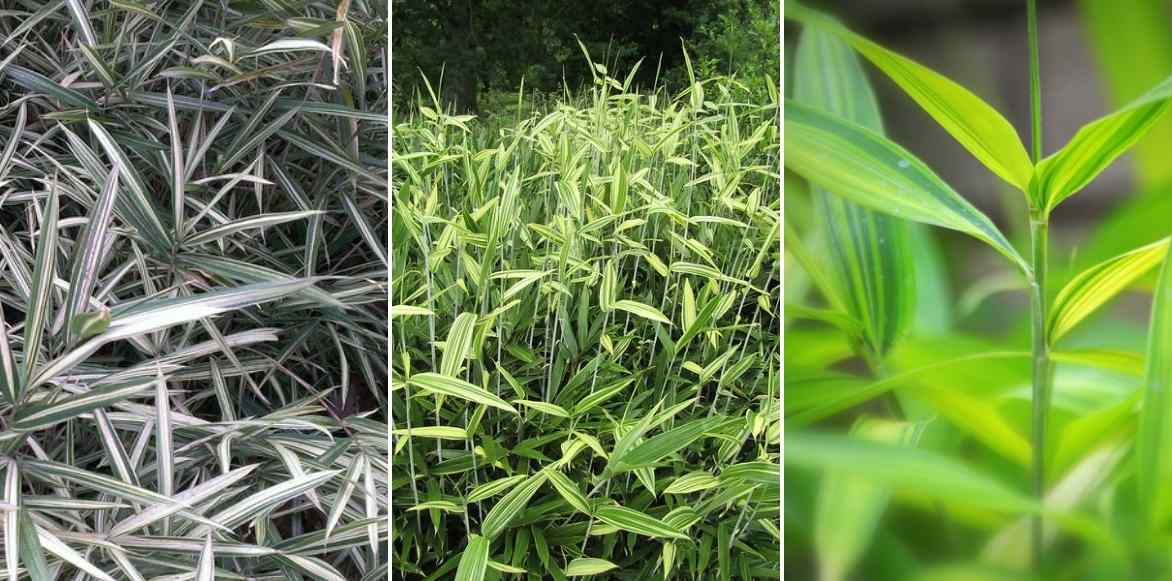
Pleioblastus fortunei ‘Variegatus’, Pleioblastus variegatus (© Leonora Enking), Pleioblastus viridistriatus
The dense and evergreen or semi-evergreen foliage, depending on the severity of winter, consists of small linear, lanceolate leaves, displaying a range of greens from bright green to soft green, but also variegated in Pleioblastus viridistriatus ‘Vagans’ and Pleioblastus fortunei ‘Variegatus’ (‘Variegata’), or golden in Pleioblastus auricomus. Their colour varies according to species and varieties, and they can be striated or edged in beige or yellow.
Read also
Bamboo: a successful planting in 4 stepsMain species and varieties
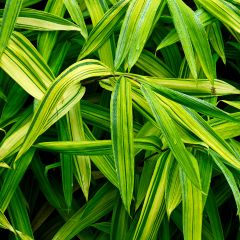
Pleioblastus auricomus - Dwarf Bamboo
- Height at maturity 70 cm
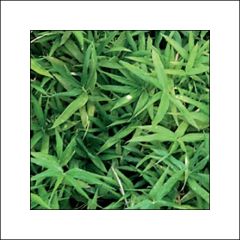
Pleioblastus viridistriatus Vagans - Dwarf Bamboo
- Height at maturity 70 cm
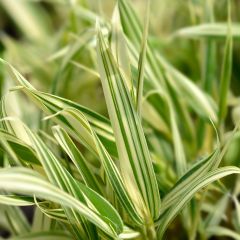
Pleioblastus fortunei Variegatus - Dwarf Bamboo
- Height at maturity 1 m
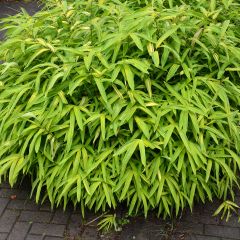
Pleioblastus argenteostriatus Pumilus - Dwarf Bamboo
- Height at maturity 80 cm
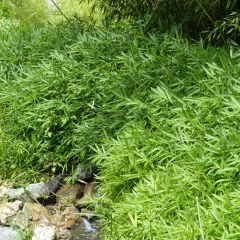
Pleioblastus pygmaeus Distichus - Dwarf Bamboo
- Height at maturity 60 cm
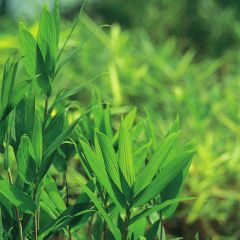
Pleioblastus pygmaeus - Dwarf Bamboo
- Height at maturity 50 cm
Discover other Pleioblastus
View all →Available in 1 sizes
Available in 2 sizes
Available in 2 sizes
Available in 1 sizes
Available in 1 sizes
Available in 1 sizes
Available in 2 sizes
Available in 1 sizes
Available in 1 sizes
Available in 1 sizes
Planting Dwarf Bamboo
Where to plant?
Robust, perfectly hardy down to -25°C and truly low-maintenance, Pleioblastus can be grown in all regions. It also tolerates moderate drought and thrives in all exposures, whether in full sun, partial shade, or even in the shade in southern France. However, in the coldest regions, avoid exposing it to icy winds in winter, as the foliage may suffer.
It is very tolerant of soil type and will thrive in any well-drained soil without excessive lime, remaining moist but not too dry throughout the year. However, like all bamboos, it is sensitive to waterlogged soils in autumn and winter.
It also copes well with root competition.
Being colonising by nature, this running bamboo spreads more or less quickly depending on the growing conditions. Therefore, think carefully about its placement. Its dense underground network of rhizomes helps to retain soil on rocky areas and slopes. To contain its growth, we recommend reserving a large, unproductive slope for it or using anti-rhizome barriers if you plant it among a bed of perennials or bushes, for example.
This type of bamboo is easy to plant in a small garden. Groundcover enthusiasts will plant it in low hedges, such as along borders or even at the edge of woodlands or in light woodland. The shorter species can replace grass in non-trodden areas. This bamboo is particularly well-suited for pot cultivation to green up a balcony, terrace, or even a very bright and cool interior.
Check our advice sheet to learn how to install a rootstock barrier.
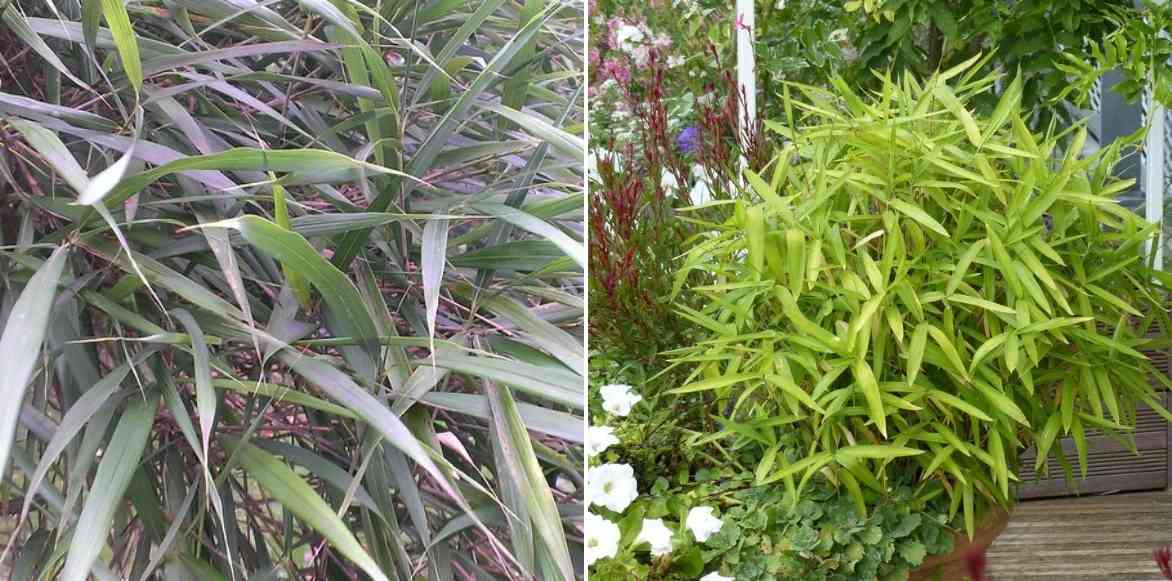
Pleioblastus linearis and Pleioblastus distichus in pots on the terrace
When to plant dwarf bamboo?
Planting Pleioblastus is ideally done in autumn, from September to mid-November. Recovery will be optimal: the soil will still be warm, and autumn rains will favour good rooting. Spring planting is possible, provided that watering is closely monitored.
How to plant?
In the ground
Plan for 1 to 3 plants per m², depending on the species and the desired density of groundcover. Be sure to install an anti-rhizome barrier at the time of planting.
- Soak the root balls in a bucket of water before planting
- Loosen, weed, and thoroughly aerate the soil
- Dig a hole that is wide and deep, two to three times larger than the root ball
- Spread gravel at the bottom of the hole, especially if the soil is compact
- Prepare a trench around the planting hole to accommodate your dwarf bamboo
- Install the anti-rhizome barrier around the perimeter, allowing it to extend about 5-10 cm above ground and tilting it outward
- Position the root ball in the centre of the hole
- Backfill with garden soil mixed with potting soil
- Add compost if the soil is too poor
- Firm the soil around the roots
- Water generously
- Mulch at the base with mineral mulch to retain moisture during summer
In a pot
- Choose a container with a base that is at least 30 to 40 cm in diameter
- Place a layer of clay balls or pumice at the bottom of the pot
- Plant in a rich, well-draining mix of potting soil and sand, perlite, or vermiculite
- Water thoroughly and then regularly
Read also
6 bamboos to grow in potsMaintenance, pruning and care
In open ground
Pleioblastus, like all bamboos, is thirsty for water. During the first year after planting, especially in summer, water regularly to ensure establishment. Although this bamboo tolerates short periods of drought fairly well, it is important to water frequently during dry summers or heatwaves. In cases of intense drought, mist the foliage in the evening or morning to prevent drying out. The bamboo also needs water in winter: remember to water it occasionally.
Mulch young plants and allow the dry leaves of the bamboo to form a natural mulch at the base of the culms.
It grows faster in well-fertile soil: an application of organic fertiliser twice a year will be beneficial.
In pots
A potted bamboo must never lack water. Carefully monitor water supplies, never allowing the root ball to dry out completely. Water very regularly but without excess, especially during hot weather.
Apply slow-release nitrogen fertiliser at the beginning of spring.
In winter, reduce watering. Repot every 2 to 3 years, topping up in the meantime to refresh the depleted surface substrate.
Pruning dwarf bamboos
Pleioblastus tolerates pruning very well, to the extent that it can be trained as a bonsai for enthusiasts. Every year at the end of winter, cut back the clumps with shears to rejuvenate them and encourage the growth of fresh foliage. Also, remove any dead or dried culms. Very low Pleioblastus forming large groundcovers will only require one or two mowings per year.
Possible diseases
Pleioblastus is a species that is not very susceptible to diseases and pests.
→ Learn more in our article Diseases and pests of bamboos.
Multiplication
It is very easy to obtain new young plants of Pleioblastus by dividing the clumps in spring or autumn, even though this bamboo naturally multiplies on its own! If possible, proceed after rain, as this will make the task easier.
- Using a spade, dig up a part of the clump containing at least 3 culms
- Shorten the culms by one-third of their length while always keeping some foliage
- Replant the divisions without delay in well-prepared soil
- Fill in, firm down, and mulch
- Water generously and then keep the soil moist to encourage root recovery
Pairing ideas
With moderate growth, Pleioblastus are easy to associate and integrate into a small garden. To create undeniably exotic scenes, they can be paired with other less invasive bamboos like Fargesia (Fargesia denudata, F. rufa, F. murielae), which will remain well in place. In a zen garden, they blend beautifully with other Asian plants, such as Japanese grasses, Japanese maples, azaleas, or even with Hakonecloa macra Aureola.
In a shrub border, they accompany heavenly bamboo, arborescent heathers, and Leptospermum. In a light woodland, they will be stunning as groundcover under trees such as the caramel tree or Acer griseum, which they will enhance.
In a Japanese garden, inspired by zen, they will be pruned into bonsai and staged with grasses and dwarf conifers with blue foliage (Picea pungens ‘Jeddeloh’) for a clean and graphic effect. Their association with Elegia capensis, a truly exotic perennial, is always successful.
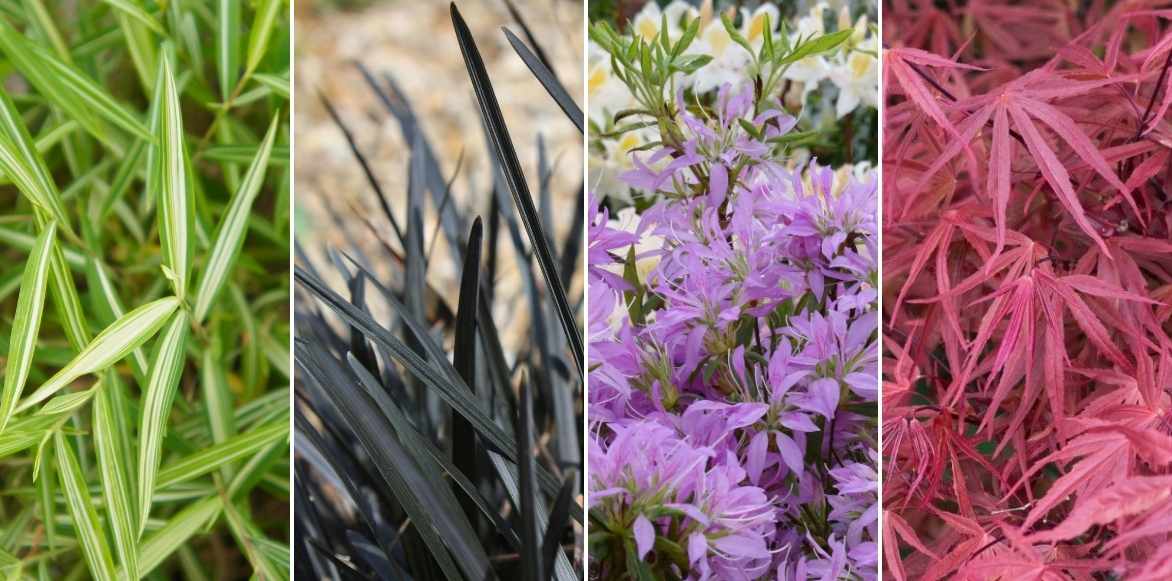
Pleioblastus shibuyanus ‘Tsuboii’, Ophiopogon plansicapus ‘Nigrescens’, Japanese azalea ‘Koromo Shikibu’, and Acer palmatum “Inaba-Shidare”
Useful resources
- Discover our wide range of bamboos!
- Visit the Bambouseraie d’Anduze in France!
- Discover 6 bamboos to grow in pots!
- Discover dwarf bamboos
- Read our tips on how to water a bamboo in a pot
- Discover our series on travelling plants: bamboo
- Subscribe!
- Contents































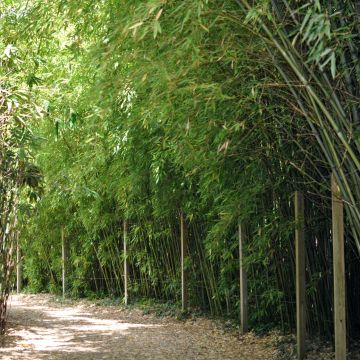


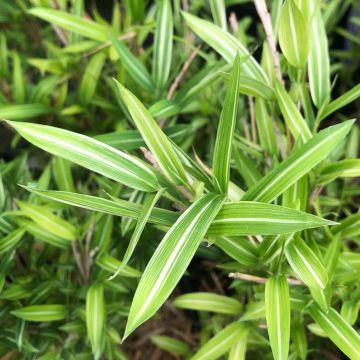
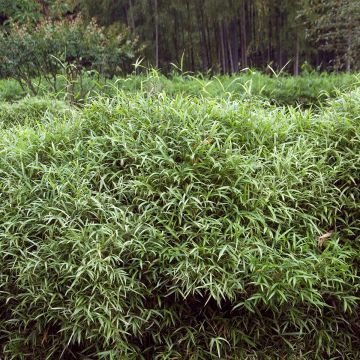
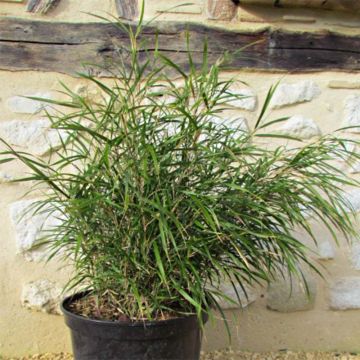




Comments